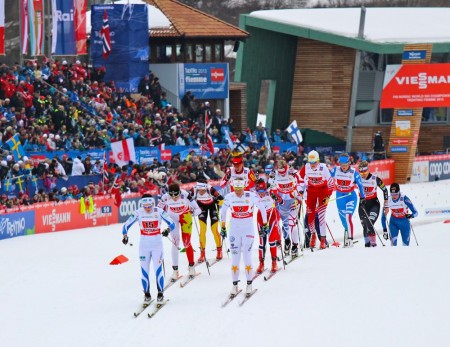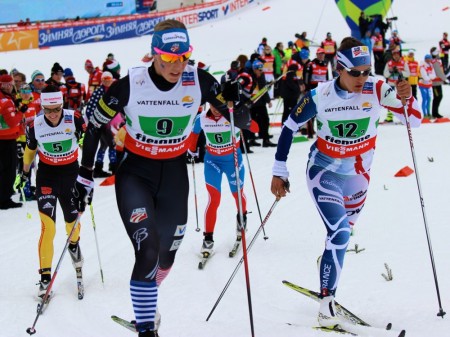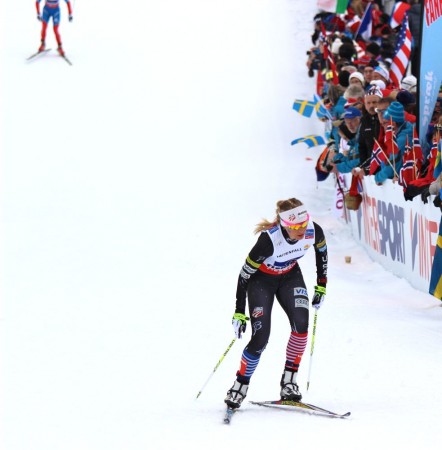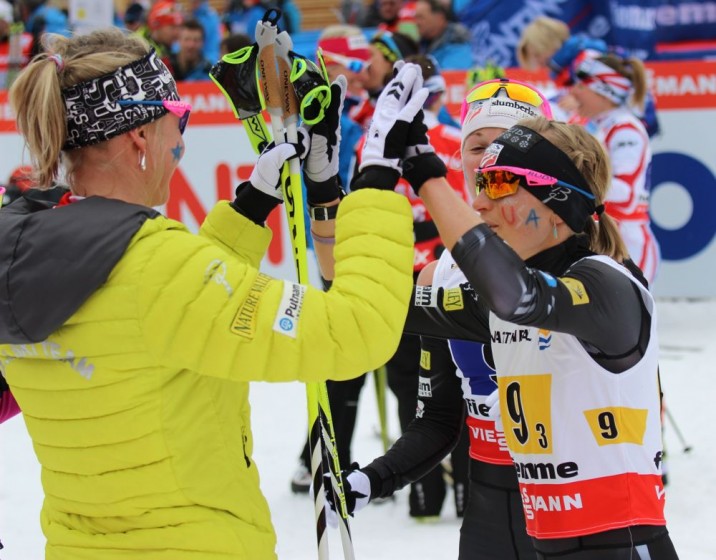
FasterSkier’s coverage of the 2013 FIS Nordic World Ski Championships in Val di Fiemme, Italy, is brought to you by the generous support of Fischer Sports.
VAL DI FIEMME, Italy – After producing enormously significant results at World Championships this week and with confidence from a bronze-medal relay performance in Gallivare, Sweden, this season, expectations were high for
Sadie Bjornsen, Kikkan Randall, Liz Stephen and Jessie Diggins in the 4×5 k on Thursday. They’ve tasted the podium and wanted to reach it again, but after four gutsy legs the Americans had to settle for fourth place behind Norway, Sweden and Russia, 26.6 seconds out of third.

“As a team you always hope for a medal, but man, fourth feels like a medal to me today,” Stephen said. “I mean, everybody skied their hearts out. Jessie could have easily decided that fifth was good enough and she couldn’t get fourth, and on that last climb she just decided, ‘I’m getting fourth.’ And she did it. And to me, that’s a medal.”
Fourth is the best result the United States has ever had in a relay, men’s or women’s, at a World Championships or Olympic Games. Bjornsen’s and Randall’s positioning in the classic half of the race set Stephen up to make a huge jump from ninth to fourth in the third leg. Diggins, after getting passed by a charging Yulia Tchekaleva (RUS), kept motoring on her own to catch Finland on her last lap and keep the Americans in fourth by well over ten seconds at the end.
“At first I was so disappointed in myself for losing the medal, because we were catching on,” Diggins said. “It was really hard not to be able to stay with the Russian girl, but I tried my best and you have to be satisfied with that because I couldn’t have pushed any harder.”
All her teammates felt they poured every ounce of energy they could muster into the race. The circumstances might not have been perfect for each of them, but at the end of the day they knew they skied with what they had.
“I think you could talk to every one of those girls and they could find places where they got tangled up or died over the top of a hill, but that’s relay racing,” said U.S. Ski Team women’s coach Matt Whitcomb. “It’s a testament to just how strong we are… It’s not just one person, it’s about us all putting it together.”
Bjornsen started things off for the Americans to keep the team in a fighting position. The early pack was a jittery one that featured at least one tangle between Germany and Finland on the first lap, but Bjornsen largely stayed out of trouble. She briefly caught a ski in the fence at the top of the course, but progressed to tag off to Randall in sixth place in a close group just behind Austria and Germany.
“It was pretty good,” Bjornsen said of her leg. “Midway through those girls took off and from the back you couldn’t really tell. All of a sudden I looked up and they were gone, and I just scrambled and tried to chase them down.”
She lost a bit of contact with the two women directly in front of her with the hiccup with the fence, but kept the opportunity there for Randall to catch back on.
“I had to try to tell myself to get up quickly, but unfortunately the two other girls had taken off and from there it was just chasing all the way until the end,” Bjornsen said.

The second leg, as Randall willingly acknowledged afterward, was perhaps the Americans’ weakest. She left the stadium on the tails of Finland and felt “comfortable” making up ground to a small pack with Germany and Austria on her first loop, but on her second time through the course her legs got “kind of flooded” and she lost ground. By the time she tagged off to Stephen the U.S. had dropped to ninth, though still within striking distance of Germany and Austria.
“It wasn’t the leg I wanted to have today,” Randall said. “It was going pretty well on the first lap but the second lap I just didn’t have anything to go to. It’s frustrating to be so close to a medal today knowing that my leg could have mattered that little extra bit, but I skied with what I had today. The trend of the distance racing isn’t so good right now.”
Though Randall felt at fault for a loss of positioning, Stephen skied the fastest third leg in the entire field to put the team back in the hunt. Demonstrating the same intensity she showed two days prior in the 10 k, she scampered up the climbs to drop her nearest competitors and catapult the U.S. from ninth to fourth. When she gave Diggins the tag they were 25 seconds behind Finland in third and eight seconds ahead of Russia.
“I don’t like clingers, I don’t want people on my tail, I don’t like to be on people’s tails,” Stephen said of her skiing. “I just like to go out as hard as I can and drop people, because in a sprint I will lose every time… I pretty much just always want to go by, and I had no idea how much space I had between the next girl. I didn’t look back and I just went, so no strategy at all, I guess.”
Diggins had her work cut out for her on the last leg to hold the position. With Finland so far in ahead and a strong Tchekaleva closing in from behind she was forced to do the work to close in on third while attempting to keep Russia at bay. But Tchekaleva, the bronze-medalist from the 10 k, proved too much for her on this particular day and passed the young American on the first lap.
“I didn’t have any possibility to reach her for a long time, but I saw her just on the length of my hand,” Tchekaleva said through a translator. “So first I tried to reach [Diggins] and then I saw the Finnish girl.”

When Russia passed her, Diggins avoided getting discouraged with the help of teammates telling her from the sidelines that Finland’s Riikka Sarasoja-Lilja was losing steam.
“It was hard,” Diggins said. “Russia had passed me and I was like, “Aw man, hang on, hang on, hang on.’ You never know what happens, maybe she’ll trip or something, you can’t give up. And coaches kept telling me ‘Finland’s dying, hang on!’ But it’s so hard to keep pushing when you’re just skiing by yourself. But I could hear the coaches yelling and my teammates were so awesome cheering.”
Diggins caught and passed Finland near the top of the last climb on the last lap of the course.
“She was fading and I was trying so hard to just not lose us a place,” she said.
Those that watched the race from the top of the course could see that Diggins completely redlined in the last few minutes.
“Jessie caught Finland on the last climb and just switched on all her anaerobic fibers,” Whitcomb said. “I mean, she was yelling over the top of the last hill she was so exhausted. Just like, ‘Ahhh!’ And absolutely put Finland well behind her so she could ski into fourth.”
Diggins collapsed after the finish and Finland came through 11.4 seconds later. After being initially disappointed with missing the podium, she reasoned that cutting their ninth-place finish from Oslo two years ago by over half was a positive day.
“If we keep on that trajectory it’s looking pretty good [for next time],” Diggins concluded.
It’s worth mentioning that the women’s team’s lineup was a tough decision for coaches to make. Ida Sargent and Holly Brooks were alternates, but Whitcomb believes either of them would have made excellent replacements.
“It’s much easier when you have only four candidates, but we have six,” he said. “We’ve had several instances this year we’ve had to make some very tough calls. All six women have outgrown our World Cup start quota and that’s particularly the case at World Championships, where you can only start four. So it’s a great problem to have, but not an easy one to have.”
On the whole, the fact that the team was encouraged but not unequivocally happy with the best relay finish the U.S. has ever had says a lot about where the team expects itself to be competitively.
“We know for sure [a medal] is possible now,” Randall said. “When we all put together solid legs, we’re right in the fight and we were so close today. Sadie skied great, she skied right where she needed to, I was in there until 2 k to go, and Liz and Jessie obviously skied fantastic. We’re so close to being medal-worthy. Yeah, I’m personally disappointed to be the one that was kind of at fault today, but I think a year from now at the Olympics it could be a really exciting event for us to look forward to.”
Whitcomb concurred.
“I’m really happy with today,” he said. “We had four girls that skied our hearts out and we have two more sitting in reserve that could have also skied their hearts out and served as legitimate substitutions. I’m more encouraged than I ever have been, as we head to the end of these championships and start focusing towards Sochi, on our prospects for winning a relay medal. Fourth place is always difficult, but we definitely don’t see that. We see one of the best results we’ve ever had as a team that is coming together more and more every day that passes. There’s no team here today in the world that is more hungry for Sochi now, to repeat this race.”
— Alex Matthews contributed reporting.

Audrey Mangan
Audrey Mangan (@audreymangan) is an Associate Editor at FasterSkier and lives in Colorado. She learned to love skiing at home in Western New York.




11 comments
highstream
February 28, 2013 at 7:45 pm
Final result aside, I remain genuinely curious why the easily fastest distance skater, above all on a steep course, is placed in third relay position. Notice that the top three finishers didn’t do that, but virtually all the rest of the teams did this time around. Coincidence? Looking at Gallivaere and La Clusaz, it seems to happen more often than not.
Why is every best U.S. result “historic?” Quite aside from its overuse in sports, I’m not sure what’s historic about coming in fourth or fifth.
annoymous
February 28, 2013 at 8:41 pm
Dude, don’t be that guy…
sportalaska
March 1, 2013 at 1:04 am
Hey Highstream –
A little history lesson:
Bjorn Daehlie – arguably greatest male World Cup skier ever – he normally skied 3rd leg in Norway’s relay team and Alsgaard went last
Gunde Svan – you could argue between him and Daehlie for hours – he normally skied 3rd leg for Sweden, with Mogren 4th.
You must question their coaches’ logic, but those relay teams, with the “superstars” running 3rd, won a lot of World Cup, World Championship and Olympic relays.
Why send the “best” skier out 3rd and not last? There is much more that goes into putting together a relay team order than who is fastest. Some people ski over their heads in some situations and those same people might fade in other situations. It’s the coaches’ job to put the skiers in the order where their physical and mental skills permit them to perform their best. Some skiers like to chase, some skiers like to hang, some skiers like to ski from the front.
The US Ski Team coaching staff knows these skiers a lot better than any of us do. I’ll trust them with the running order of the relay team.
And a US team placing 4th IS historic.
John Estle
Lars
March 1, 2013 at 4:23 am
I think sprinting ability is considered important on the last leg. So that could be a factor in why Diggins was chosen for that leg and not Stephen
Jake
March 1, 2013 at 7:20 am
I agree with everything John Estle said.
But it *is* fun to pretend we know more than the experts (coaches)… let’s look at the numbers and then speculate.
So you swap Diggins and Stephen. This would mean Randall tags off to Diggins close together with Italy and Austria, 4 seconds back from Germany, 10 from France, 14 from Russia. Based on the split times alone, this would put Diggins finishing her leg close together with Germany and France (Italy and Austria faded in the 3rd leg). The 3rd leg Russian skied nearly the same split as Diggins, so they end just the same as they start 13 sec up on the US. Having watched the race and seen how obviously hard Diggins was trying and how much time she made on the Finn in the last 1.5km I tend to think it’s unlikely but let’s go ahead and speculate that working together with Germany and France, Diggins closes those 13 seconds on the Russian.
So Stephen starts head-to-head with Tchekaleva. The only person who skied faster than Liz yesterday on the skate legs was Tchekaleva, by 13 seconds (not counting any end-of-race-celebration slow-down that she had). Again, from watching I find it hard to believe that Liz could have found 13 more seconds to hang with the Russian – she skied her heart out there! And even if she did, she would still need to out-sprint Tchekaleva for the bronze (a task Diggins has already shown in both relays she’s skied that she excels at). Both Stephen and Tchekaleva seem to be pure distance racers so who knows what would have happened, but it all seems like a bit of a stretch.
No, the coaches know what they’re doing and the athletes kill themselves out there. I think Stephen and Diggins demonstrated in their respective legs that they are the ideal choices for 3rd and 4th legs respectively. I prefer to think if all 4 athletes have extra-special days and ski just ~7 seconds faster, they nab the bronze. Heck, it doesn’t even take 20 seconds improvement per athlete to win the whole darned race! I bet that provides some serious motivation over the summer.
I, for one, can’t wait for another historic result. Go team!
Martin Hall
March 1, 2013 at 7:41 am
All the conjecture about who runs where most likely has nothing to do with the yesterdays out come–you had one great day from Liz, two OK plus days from Jessie and Sadie and a lousy leg from Kikkan—it’s that simple—Kikkan skis her normal leg and a silver medal is the reward for the day.(no one is touching that Norwegian team right now) The future is bright—but like it has been said many times over—-you have to all four ladies firing on all cylinders to make the podium.
All those ladies did everything they could yesterday—that’s a for sure in my mind—-but Kikkan is now paying for those lost hours from her foot injury all through the summer and early fall—-her racing has been sketchy the last couple of weeks and now the challenge is on, to how she sneaks through the rest of the season.
Kudos to Lizzy—I said it this fall when she won the Whiteface hill climb in a mind blowing time for a new record—lets hope that lady reaches Europe, as she is podium material, and she is showing this last week. Hope it is still there for the 30km—a lot of other stars are now getting tired.
nyctvt
March 1, 2013 at 8:59 am
Maybe Ida Sargent would have been a better pick then Kikkan, but that is Monday morning quarterbacking. Nice job girls!
4skiers
March 1, 2013 at 9:29 am
While it’s clear the Liz was the breakout US performance of the day, FIS rated Diggins as much better than “OK” plus:
http://www.fiemme2013.com/en/detail.php?box=news&uuid=3151923BA70A4A8D85D60825A3950BE0
highstream
March 1, 2013 at 11:51 am
Noticing the U.S. team order got me looking at the results for everyone, and not just for one race because that can be affected by any number of factors (such as tactical maneuvering, as in today’s mens relay). But to single out the U.S. women’s team relay results, it’s been the same consistently, with Diggins skiing well slower than Stephen and losing places despite her very best efforts. And the last time this happened, I also asked, why the rookie in the anchor position? I’m sure the USST coaches have good reasons (which few are privvy to). I’m interested in hearing how these things are thought through, because on the face of it, it’s not obvious in the U.S. case. And “trust” is not an answer, because it’s not the question.
Martin Hall
March 1, 2013 at 11:53 am
Diggins was a much better horse in her last leg of the team sprint then she was in the last part of her leg in the relay—no question on effort—but, in the relay—she looked tight, head was moving and I can tell you if you were watching the race when they went out of camera view on the last up hill I know I was surprised when she came out a head of the Fin and I’m sure most of you guys who were watching thought—how the heck did that happen—she was the better of the two tired horses that were fighting it out for 4th place. She had control in the sprint—the lactic acid backpack had control in the relay. I can bet you she was soooo happy to get across that finish line–
For ncytvt—any of the other ladies would have been better than Kikkan—she was 1:20 slower the you would expect—-she wins that 2nd leg hands down 99% of the time—-like I said—-silver medal if she is normal—watch these last two weeks—the recovery game is on—-what do you think her chances are of being on the 30km start line tomorrow mrng—–I say zero—what do you think?
shreddir
March 2, 2013 at 1:02 am
If the air temperature shoots up and the snow becomes that slow suction wet transition garbage..uggh!! like we often have soon after big dumps out here in California, I predict Justyna will finally win her gold. With her grinding lumbering classic stride and her heavier hulk-like physique she will pull away from the lightweight little Norwegian girls like Therese Johaug and Heidi Weng on the downhills..it’s all about momentum. If the snow could stay cold and fast then Therese and Marit could use their lighter subtle touch and snappier body movement to accelerate away from Kowalcyzk. But this time I afraid pure power and ugly grinding locomotion on the long relentless uphills is going to win the day. That is unless Justyna’s Estonian ski prep guru totally blows the kick wax and/or misses the right glide zone base structuring and Cera F voodo combination. I not sure how much Liz Stephen can be a factor because she seems to do most of her damage skiing freestyle not classic.